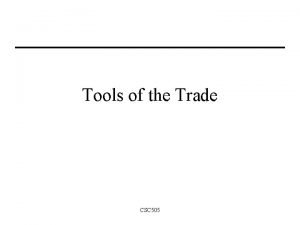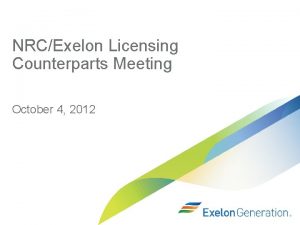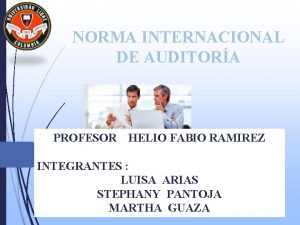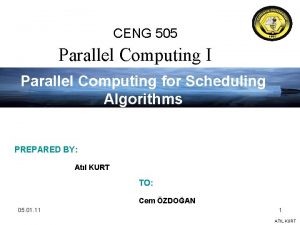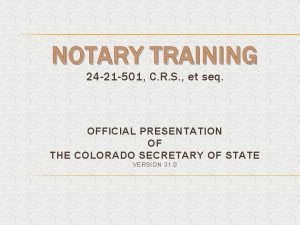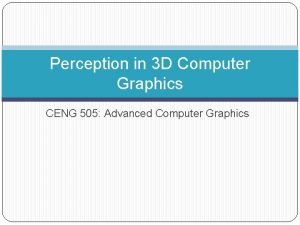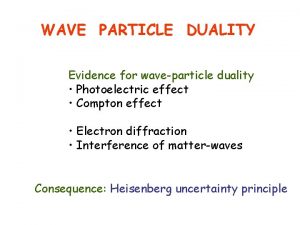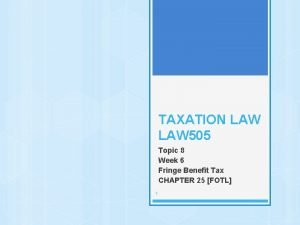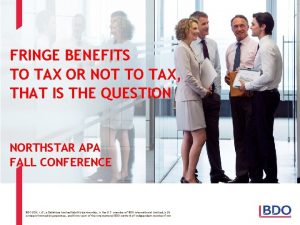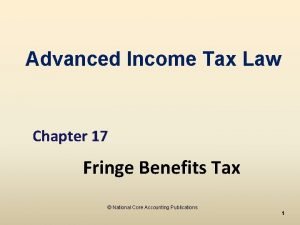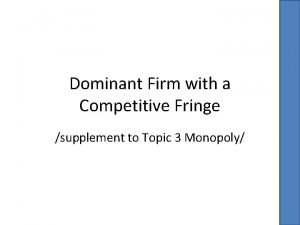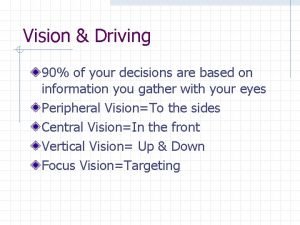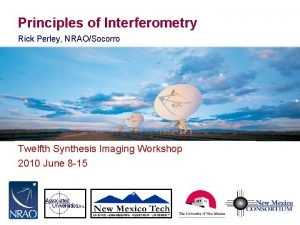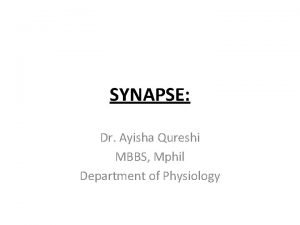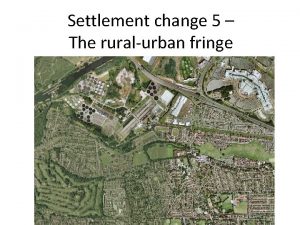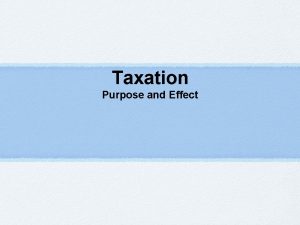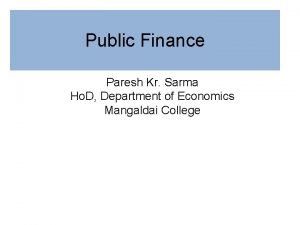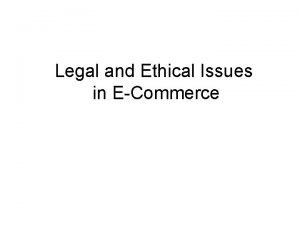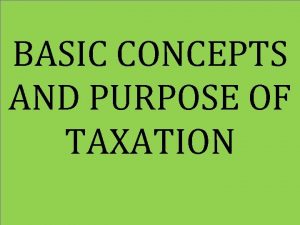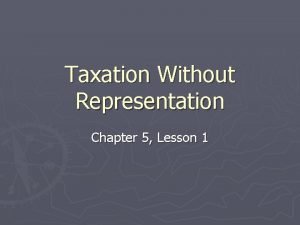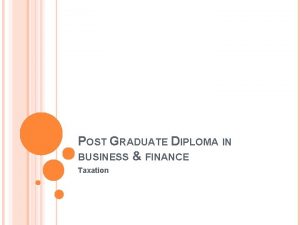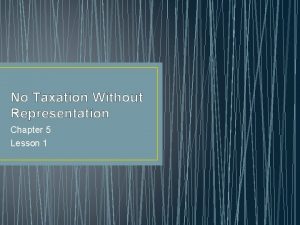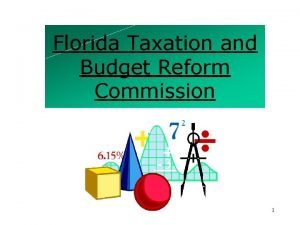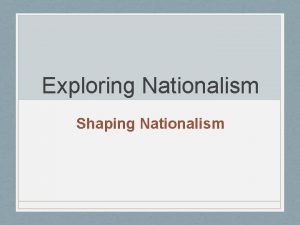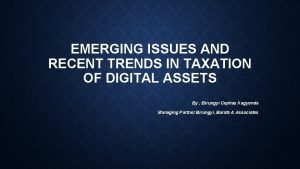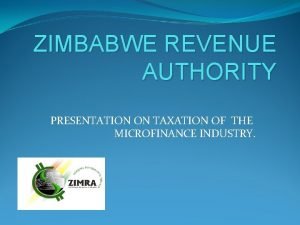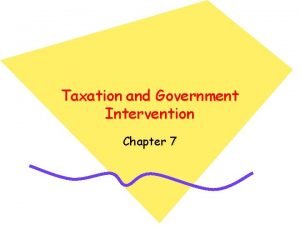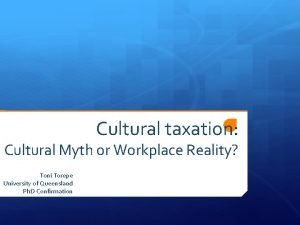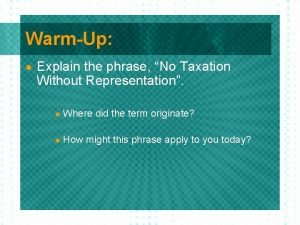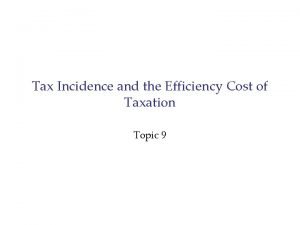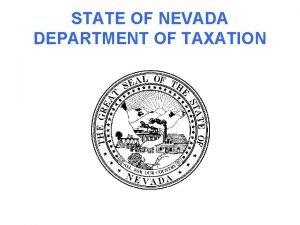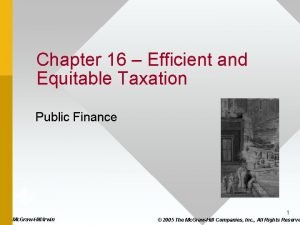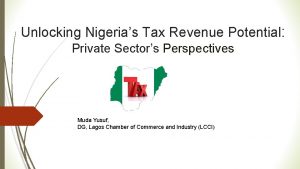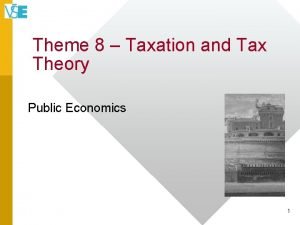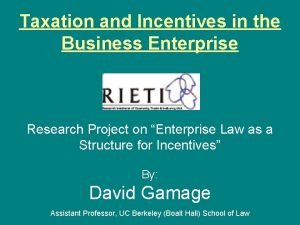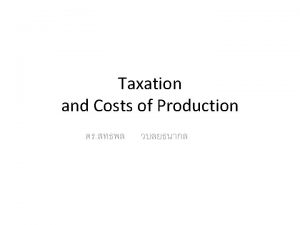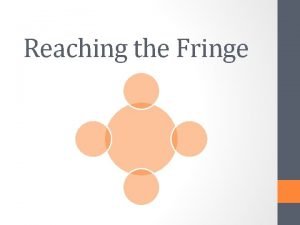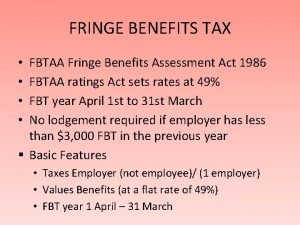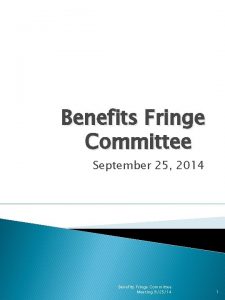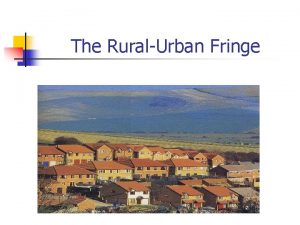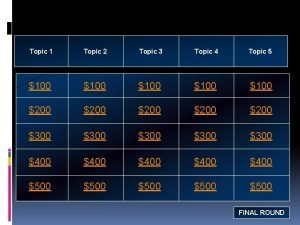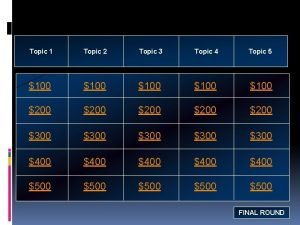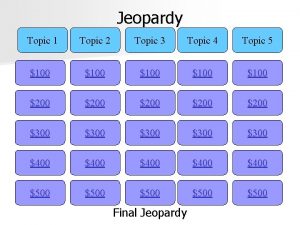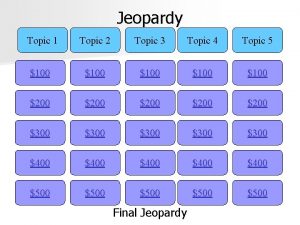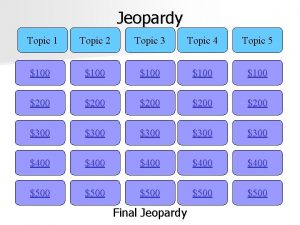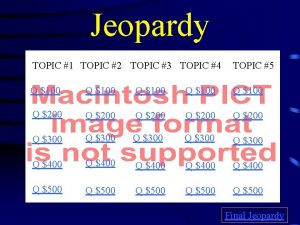TAXATION LAW 505 Topic 8 Week 6 Fringe
![TAXATION LAW 505 Topic 8 Week 6 Fringe Benefit Tax CHAPTER 25 [FOTL] 1 TAXATION LAW 505 Topic 8 Week 6 Fringe Benefit Tax CHAPTER 25 [FOTL] 1](https://slidetodoc.com/presentation_image_h/2de63dea4153e18efcf8cf1021df52f6/image-1.jpg)

























































- Slides: 58
![TAXATION LAW 505 Topic 8 Week 6 Fringe Benefit Tax CHAPTER 25 FOTL 1 TAXATION LAW 505 Topic 8 Week 6 Fringe Benefit Tax CHAPTER 25 [FOTL] 1](https://slidetodoc.com/presentation_image_h/2de63dea4153e18efcf8cf1021df52f6/image-1.jpg)
TAXATION LAW 505 Topic 8 Week 6 Fringe Benefit Tax CHAPTER 25 [FOTL] 1

2 FBT Assessed under Fringe Benefit Tax Assessment Act 1986 when it was introduced on 1 July 1986 Non assessable non exempt income s 6 -5 ITAA 97 or s 15 -2 ITAA 97 Tax payable by employer and is deductable for FBT paid Rate of tax is 46. 5% on the FB taxable amount Tax year – 1 April to 31 March s 136(1)FBTAA

3 Benefit in respect of employment or services Allowances in respect of employment or services Employee liable for tax s 15 -2 ITAA 97 S 6 -5 ITAA 97 S 15 -2 ITAA 97 Does not apply Employer not liable for tax s 23 L(1) ITAA 36 Tangible fringe benefit Non assessable non-exempt income s 6 -23 ITAA 97 S 66 FBTA 86 Applies Employer liable to tax Exempt fringe benefit Exempt income s 6 -20 ITAA 97 s 23 L(1 A) ITAA 36 Employee not liable for tax S 136(1)(g)ITAA 36 Employer not liable for tax

4 Steps to determining FBT Step 1 – Identify if there is a fringe benefit Step 2 – Determine the taxable value (TV) Step 3 – Apportion out private use (if any) Step 4 – Reduction factor (if any) Step 5 – Total all TV Step 6 – Gross up TV Step 7 – Apply FBT rate (currently 46. 5%)

5 Computation of TV of FB Section 5 B(1 A) FBTAA Employer’s Fringe benefit taxable amount is sum of s 5 B(1 B) and s 5 B(1 C) Type 1 aggregate if the employer is entitled to a GST input tax s 5 B(1 B) = Type 1 aggregate fringe FBT rate x GST rate benefit amount (1 -FBT rate) x (1 + GST rate) x FBT rate = 2. 0647 Type 2 aggregate is all other FB which are not GST creditable benefit s 5 B(1 C) = Type 2 aggregate fringe 1 = 1. 8692 benefit amount 1 – FBT Rate Fringe benefit taxable amount = Type 1 aggregate fringe benefit amount x 2. 0647 Type 2 aggregate fringe benefit amount x 1. 8692 + Aggregate nonexempt amount

6 Definition of FBT Defined under s 136(1) FBTAA Positive limb definition s 136(1)(a) to (e) is a benefit provided during , or in respect of, the year of tax By an employer, an associate of an employer, or a third party under an arrangement with the employer or associate of the employer To an employee or an associate of an employee In respect of the employment of the employer

Definition of FBT 7 Negative limb definition s 136(1)(f)-(s) s 136(1) FBTAA excludes the following from FBT Payment of salary and wages A benefit that is an exempt benefit in relation to the year of tax A benefit constituted by the acquisition by the employee, or by a relative of the employee of a share or right over a share The making of payment of money to a superannuation fund The payment of money to an Retirement Savings Account An eligible termination payment Consideration of a capital nature for, or in respect of a legally enforceable contract in restraint of trade by a person or personal injury to a person or a grant or acquisition of such carried interest , or of an entitlement to such payment or a deemed dividend paid to the recipient

8 There must be a benefit Not all benefits provided by the employers to employees are fringe benefit. The benefit must be “in respect of “ employment ie sufficient nexus to their employment Case law Slade Bloodstock Pty Ltd v FCT (2007) 68 ATR 911 Taxpayer operated a business and provided benefits to its director/shareholder Mr & Mrs Slade to partially discharge a loan to the taxpayer. Held Benefits provided by the company to director/shareholder in repayment of a loan were not provided “in respect of” the employment as they related to the shareholders’ entitlement as creditors of the taxpayer

In respect of employment 9 Case law J & G Knowles & Associates Pty Ltd v FCT Facts The taxpayer was the corporate trustee of a unit trust that had been established to conduct a business of constructing, selling and managing retirement villages. The trustees of 4 separate discretionary trusts each held 25% of the units in the Trust. The 4 directors of the taxpayer together with their families were the beneficiaries of the respective discretionary trusts. The directors withdrew amounts from the taxpayer’s cheque account. The amounts withdrawn bore no relationship to the personal efforts of the directors and were treated as loans to the directors. Held There is no fringe benefit. For a benefit to qualify as a fringe benefit, it is not sufficient that there is some causal connection between the benefit and the employment. The requisite connection will not exist unless there is some discernable and rational link between the benefit and the employment.

Identity of employee 10 The identity of the particular employee at the time of the benefit is granted must be known Case law FCT v Indooroopilly Children Services (Qld) Pty Ltd (2007) 65 ATR 369 Facts ABC Public established an employee share scheme using discretionary trust. Terms of trust deed provided trustee to allocate shares to benefit franchisee employee according to certain criteria. The initial share issue was to be calculated by reference to the number of employees of the Regional Management Co (RMC) who had signed AWAs, the length of employment with RMCs and other criteria. The issue was not to involve any specification as to the number or value of shares to which any individual employee would be entitled. The trustee would exercise its discretion to issue shares to particular employees at a later time having regard to matters such as their employment position and their years of service. Held Shares gifted by an employer to the trustee of a discretionary trust did not give rise to a fringe benefit because the shares were not provided in connection with any particular employee

11 Exempt employers Div 13 provides the employers who are exempted from FBT Religious institution Foreign government organisation International bodies that are exempt from tax qualifying public hospitals and non profit hospital or public ambulance services (limited to $17, 000 Public benevolent institutions that are not public hospitals (limited to $30, 000)

12 Types of FB There are 13 kinds of FB which taxable values are calculated differently (Div 2 -12) - car benefits s 7 - Debt waiver benefit s 14 - Loan benefit s 16 - Expense payment benefit s 20 - Housing benefits s 25 - Living away from home allowance benefit s 30 - Airline transport benefit s 32 - Board benefits s 35 - Meal entertainment benefits s 37 AC - Tax exempt body entertainment benefit s 38 - Car parking benefits s 39 A - Property benefits s 40 - Residual fringe benefits s 45

Car benefit 13 A car fringe benefit most commonly arises where you (the employer) make a car you 'hold' available for the private use of an employee (or the car is treated as being available). A car you hold generally means a car you own or lease. The following types of vehicles (including 4 WD drive vehicles) are cars: motor cars, station wagons, panel vans and utilities (excluding panel vans and utilities designed to carry a load of one tonne or more) all other goods-carrying vehicles designed to carry <1 tonne all other passenger-carrying vehicles designed to carry < 9 occupants. You make a car available for private use by an employee on any day that: it is actually used for private purposes by the employee, or the car is available for the private use of the employee.

14 Car benefit cont. . A car is treated as being available for private use by an employee on any day that: the car is not at the employer’s premises, and the employee is allowed to use it for private purposes, or the car is garaged at the employee's home. A car that is garaged at an employee's home is treated as being available for the private use of the employee regardless of whether they have permission to use it for private purposes. Similarly, where the place of employment and residence are the same, the car is taken to be available for the private use of the employee. As a general rule, travel to and from work is private use of a vehicle.

15 Car benefit cont. . Where a car is in a workshop for extensive repairs, for example, following a motor vehicle accident, it is not available for private use of the employee. However, a car is considered to be available for private use where it is in the workshop for routine servicing or maintenance. Private use of a motor vehicle that is not a car may give rise to a residual fringe benefit If you hire a car for less than three months, you are not considered to 'hold' the car and it will not result in a car fringe benefit. However, if you make a rental car or taxi available for the private use of an employee, and the car is hired for less than three months, a residual fringe benefit may arise.

16 Computation – Car benefit computation method is either 1. “Statutory formula” method, s 9 or 2. “Cost basis” method, s 10 The statutory method for calculating FBT for year beginning on or after 1 April 2011 is as follows” N Note : 0. 2 is used for this period

17 “Statutory formula” method Pre 1 April 2011 - Statutory formula basis [s 9 FBTAA 86]: A x B x C - E D Where: A is the base value of the car when first held by the provider (s 9(2)(a)(i), (ii)) B is the statutory fraction (s 9(2)(c)) C is the number of days the vehicle is privately used or available for private use D is the number of days in the tax year, and E is the recipient’s payment, ie amount of any payment made by the employee towards the expenses

18 Statutory formula method Base value of car is based on 1. “cost price” of the car if car is owned by the provider or 2. “leased value” of the car if it is leased by the provider “cost price” and “leased value” includes expenditures directly attributable to the car eg air con but excludes stamp duty & transfer fee If car is over 4 years of the commencement of the FBT the base value is multiplying cost price or lease price by 2/3

example 19 On 1 April 2011 Bob is offered a Toyota worth $30, 000 as part of his employment contract. This car was made available for his use throughout the 2011/12 FBT year. He travelled 30, 000 km of which 20% was for his personal use. Operating cost amounts to $5, 000 which he paid $2, 000. What is his tax liability? Taxable value for 2011/12 FBT Statutory formula method = (0. 2 x $30000 x 365/35) -$2000 = $6000 -$2000 = $4000, FBT = $4000 x 2. 0647 x 46. 5% = $3840 If the car is offered on 1 April 2010, Taxable value for 2011/2012 FBT Statutory formula method = (0. 11 x $30000 x 365/365) -$2000 =$3300 -$2000 = $1300, FBT = $1300 x 2. 0647 x 46. 5% = $1248

20 “Cost basis” method Taxable value of a car fringe benefit under s 10(2) Taxable value = (C x (100% - BP)) – R C = operating cost – includes all car expenses relating to the car during the holding period including “deemed depreciation” and “deemed interest” if owned by recipient BP = business percentage R = recipient’s payment

21 Using the same example earlier Compute the taxable value using cost basis method Cost basis method = 5000 + 7500 + 2340 = $14840 Deemed depreciation = 30000 x 0. 25 x 365 = 7500 365 Deemed interest = 30000 x 0. 078 x 365 = 2340 365 25% depreciation rate for cars acquired after 10 May 2006 7. 8% is the statutory interest rate for 2011/2012

22 Special rule for emergency service cars Home garaging for certain emergency service cars will not result in a car being treated as available for private use under the 'home garaging rule'. However, if the car is otherwise made available for private use, such as by actual private travel between work and home, a car fringe benefit may arise. To qualify under the home garaging rule, at the time the emergency vehicle is garaged, it must be: used by an ambulance, police or fire fighting service have fitted exterior markings indicating such a use also be equipped with a flashing warning light and horn, bell or alarm.

23 Debt waiver benefit s 14 A debt waiver fringe benefit arises where you (the employer) waive or forgive the whole or part of an employee's debt. For example, if you sold goods to an employee and later tell them not to bother about paying the invoiced amount, you have provided a debt waiver fringe benefit. A debt owed by an employee that is written off as a genuine bad debt is not a debt waiver fringe benefit.

Loan benefit s 16 24 A loan fringe benefit arises where you provide a loan to an employee and charge a low rate of interest (or no interest) during the FBT year. A low rate of interest is one that is less than the statutory rate of interest (also known as the benchmark interest rate). The use of the term 'loan' is quite broad. For example, if an employee owes you a debt but you don't enforce payment at the time the debt becomes due, the unpaid amount is treated as a loan to the employee. Such a loan commences immediately after the due date, at the rate of interest (if any) that accrues on the unpaid amount. If you later decide to recover the debt, a loan benefit continues to arise provided the employee is still obliged to repay the outstanding amount.

25 Loan benefit cont. . Where you make a loan to an employee under terms that allow for interest payments to be made less frequently than every six months, you are treated at the end of each six months as having separately loaned, at a nil rate of interest for any unpaid amount of interest. The period of the deemed loan is from the end of the six months until the interest is paid or becomes payable. However the waiver of establishment fees for employees is not FB under this provision re Westpac Banking Corporation v FCT (1936) 34 ATR 143 Where you release an employee from the obligation to repay the loan, a debt waiver fringe benefit arises s 15 FBTAA

example 26 Employer A lends money to employee B for an amount of $20, 000 at a rate of 1%pa. B repays the loan interest monthly when they fall due. During the FBT year 2011/12 he pays all the loan due but not the principal. Taxable value = (Notional value of interest – Actual value of interest) = (20, 000 x 7. 80%) – (20, 000 x 1%) = $1, 560

Loan exempt benefit 27 Loan exempt benefit, s 17 arises when : The loan provider carries on business in providing loan to the public and interest charged to the employee is no less than the public The employer makes a loan to the current employee to meet expenses in carrying his employment duties. Employee is to account for the expenses within 6 months and repay those that are not accounted for. The loan must not be significantly larger than the expenses. The employer makes a loan for the sole purpose of enabling employee to pay a rental bond, security deposit for electricity, gas, telephone services etc in relation to temporary services and loan is to be repaid within 12 months

Expense payment benefit s 20 28 An expense payment fringe benefit may arise in either of two ways: where you (the employer) reimburse an employee for expenses they incur where you pay a third party in satisfaction of expenses incurred by an employee. In either case, the expenses may be business expenses or private expenses, or a combination of the two. Note : the rules apply to expenses incurred by an employee that are reimbursed or paid by you, the employer. They don't apply to goods or services you purchase directly and provide to the employee. Nor do they apply to goods or services purchased using your credit card. Goods or services acquired in these ways are subject to valuation under the property or residual benefit rules discussed in Property fringe benefits and Residual fringe benefits. ** Need to differentiate between reimbursement and allowance

29 Expense payment benefit taxable value Taxable value of expense payment benefit is classified into 1. In-house fringe benefit consisting of a. “In-house” property expense payment benefit – relates to acquisition of property provided to the employer in the ordinary course of business b. “In-house” residual expense payment benefit - relates to acquisition of other benefits of a kind provided to the employer in the ordinary course of business (eg supply of service rather than property) 2. “External” fringe benefit – any non in-house expense Note : There is no difference in the taxable value of an inhouse fringe benefit provided directly as a property or residual fringe benefit, or indirectly as an expense payment fringe benefit.

Exempt payment benefit 30 no-private-use declaration s 20 A living away from home accommodation s 21 car expenses - expense payments s 22, 53, 61 B, 61 E and 61 F FTAA and s 15 -70 ITAA 97 employment interviews and selection tests - transport s 58 A relocation - removal and storage of household effects s 58 B relocation - engagement of a relocation consultant s 58 AA relocation - sale or acquisition of dwelling s 58 C relocation - connection or reconnection of certain utilities s 58 D living away from home - leasing of household goods s 58 E relocation - transport s 58 F motor vehicle parking s 53 newspapers and periodicals s 58 H

Exempt payment benefit. . cont 31 compensable work-related trauma (including workers' compensation insurance cover) s 58 J travel in a foreign country to obtain medical treatment s 58 L travel for compassionate reasons s 58 LA occupational health and migrant language training s 58 M emergency assistance s 58 N minor benefits s 58 P (one off < $300) long service awards s 58 Q safety awards s 58 R Australian Traineeship System s 58 S provision of certain work-related items s 58 X membership fees and subscriptions s 58 Y taxi travel s 58 Z provision of certain non-entertainment meals

Housing benefits s 25 32 A housing fringe benefit arises where an employee is provided with the right to use a unit of accommodation and the lease or licence which grants that right exists at a time when that unit of accommodation is the usual place of residence of the employee. A unit of accommodation includes: a house, flat or home unit accommodation in a hotel, motel, guesthouse, bunkhouse or other living quarters a caravan or mobile home accommodation in a ship or other floating structure. The employee does not have to have exclusive use of the unit of accommodation - the use of shared accommodation as a usual place of residence is a housing fringe benefit. If the unit of accommodation is not the employee's usual place of residence, the right to use the unit is not a housing fringe benefit. However, it may give rise to a residual fringe benefit

33 Housing benefit cont. . Taxable value of the benefit differs depending on the accommodation outside Australia, non remote or remote part of Australia. If outside Australia TV = market rate less rent paid In non remote Australia where accommodation is provider is in the business of providing similar benefits to the public TV if provider is not employer = market rate less rent paid TV if provider is employer = 75% of amount public would pay less rent In non remote Australia for any other type of accommodation = “statutory value” less rent paid. 1 st year = market rate, subsequent year is either current market value or previous year market value multiply by indexation factor If in remote Australia concessional rate applies

34 Living away from home allowance benefit s 30 For fringe benefits tax (FBT) purposes, a LAFHA is an allowance you (the employer) pay to an employee to compensate for additional expenses incurred any disadvantages suffered because the employee is required to live away from their usual place of residence in order to perform their employment-related duties. The term 'additional expenses' does not include expenses the employee would be entitled to claim as an income tax deduction.

Exempt component 35 The living away from home taxable value is amount of allowance = “exempt accommodation component” + “exempt food component” + “additional disadvantage component” “exempt accommodation component” – amount to reasonably necessarily to compensate employee for the cost of accommodation “exempt food component” - amount to reasonably necessarily to compensate employee for the increased expenditure on food. Statutory amount = $42 for adult & $21 for persons under 12. “additional expenses”- amount incurred excluding expenses the employee would be entitled to claim as an income tax deduction. Also refer to TD 2004/4 for what is reasonable

36 computation Moo was required to work away from home for 20 days. He was paid $5, 000 allowance. He spent $100 for accommodation a day and $50 a day on food and additional disadvantage of $300 Amount for the allowance = $5000 – (20 x $100) –(20 x ($50 -$42)) – $300 = $5000 - $2000 - $160 – $300 = $2, 540

37 Airline transport benefit s 32 An airline transport fringe benefit arises where employees (or their associates) of airlines or travel agents are provided with free or discounted air travel subject to the stand-by restrictions customarily applying to employees in the airline industry. Free or discounted air travel that is not subject to such restrictions is a residual fringe benefit. Taxable value is generally 37. 5% of the standard fee with first $1, 000 of benefit exempted s 62 Board benefits s 35

Board benefits s 35 38 Providing a meal to an employee is a board fringe benefit if the employee is entitled to have accommodation provided and all of the following conditions are satisfied: there is an entitlement under an industrial award to be provided with at least two meals a day, or under an employment arrangement at least two meals a day are ordinarily provided the meal is supplied by the employer - if you are a company, the meal may be supplied by a related company in a wholly owned group the meal is cooked or prepared on employer (or a related company's) premises or on a worksite or place adjacent to a worksite the meal is supplied on employer premises (or the worksite) or on the premises of a related company.

39 Board benefits s 35 Some common examples of meals that may be board fringe benefits are: meals provided in a dining facility located on a remote construction site, oil rig or ship meals provided to a live-in housekeeper or to a resident teacher in a boarding school. Meals supplied to family members living with an employee who is entitled to meals under the employment agreement or award are also treated as board meals. Taxable value = $2 per meal >12 yrs old at beginning of FBT yr & $1 if <12 yrs old, reduced by amount paid by recipient s 36

40 Meal entertainment benefits s 37 AC The provision of entertainment means the provision of: entertainment by way of food, drink or recreation accommodation or travel in connection with, or to facilitate the provision of, such entertainment. Recreation includes amusement, sport and similar leisure-time pursuits and includes recreation and amusement in vehicles, vessels or aircraft (for example, joy flights, sightseeing tours, harbour cruises). For more on valuing these types of benefits as a taxexempt body, refer to Tax-exempt body entertainment fringe benefits.

41 Meal entertainment benefits s 37 AC Some examples of the provision of entertainment are: business lunches and drinks, cocktail parties and staff social functions providing entertainment to employees and clients by providing access to sporting or theatrical events, sightseeing tours, holidays and so on accommodation and travel when it is provided in connection with, or to facilitate, activities such as entertaining clients and employees over a weekend at a tourist resort, or providing them with a holiday.

42 Taxable value of meal benefit Would ordinarily be taxed in any of the FBT rules discussed above eg property, expense payment or residual benefit depending on how it is provided. Employer may also elect s 9 A to be tax under 50/50 split method or 12 week register method If meal allowance incurred by employer = $5, 000 Benefit on 50/50 method = $2, 500 12 week register method if employee’s portion is 20% = $1, 000

43 Tax exempt body entertainment benefit s 38 A tax-exempt body entertainment fringe benefit may arise from entertainment expenses incurred by an employer who: is wholly or partially exempt from income tax, or does not derive assessable income from the activities to which the entertainment relates. If your entity is a charity, you must be endorsed in order to be income tax-exempt.

Car parking benefits s 39 A 44 Car parking fringe benefit may arise for each day on which you (the employer) provide a car parking space for the use of an employee. Specifically, a car parking fringe benefit arises during a fringe benefits tax (FBT) year only if all of the following conditions are satisfied: a car is parked at premises that are owned or leased by, or otherwise under the control of, the provider (usually you as the employer) within a one-km radius of the premises on which the car is parked, there is a commercial parking station that charges a fee for all-day parking, which is more than the car parking threshold Note : The one-km distance is measured not by radius but by the shortest practicable direct route (by whatever means this route is travelled, for example, by foot, car or boat).

Car parking benefits s 39 A cont. . 45 the car is parked for a total of more than four hours between 7. 00 am and 7. 00 pm on the day the car is owned by, leased to, or otherwise under the control of, an employee, or is provided by you the parking is provided in respect of the employee's employment the car is parked at or near the employee's primary place of employment on that day the car is used by the employee to travel between home and work (or work and home) at least once on that day the commercial parking station referred to above must also, on the first business day of the FBT year, charge a representative fee for all-day parking that is more than the car parking threshold.

46 Case law The case law Virgin Blue Airlines Pty Ltd v FCT (2010) FCAFC 137 held that 2 km away was not “in the vicinity of” the primary place of employment and subsidised car parking was not fringe benefit

47 Valuing car parking benefit 5 alternative methods of valuing car parking benefits: 1. Commercial parking station method s 39 C (default method) 2. Market value method s 39 D 3. Average cost method s 39 DA 4. Statutory formula method s 39 FA 5. 12 -week record-keeping method s 39 GA&GB These benefits can be reduced by the employee’s contribution.

48 Commercial parking station method Taxable value of the benefit is the lowest all day parking fee charged in the ordinary course of business by a commercial parking station within 1 km radius of the relevant business premise. The taxable value can be reduced by contribution of the employee. Eg Andy pays parking contribution at $1 a day, and his employer provides 200 days parking. The lowest commercial rate is $5. The taxable value of benefit = 200 x (5 -1) = $800

49 Market value method The market value method, the taxable value is based on the market value of a qualified arm’s length valuer. Average cost method The average cost method, the taxable value is determined by the lowest of all day parking fees charged by any operator of a commercial parking station within 1 km radius of employer’s premise radius on particular days ie 1 st & last day on which the benefit is provided in the FBT year.

50 Statutory formula method – taxable value of each space for which there is at least 1 car parking benefit for an employer using the formula no of days in available (Daily rate amount x period in relation to space x 228) no of days in a year contribution Daily rate amount is determined from either reipient’s a. ”Average cost” method or b. “Commercial parking station” method or c. “Market value method”

51 12 weeks record keeping method Total taxable value of car parking benefit provided is based on the total value of car parking benefit provided for a 12 week period. No of days in car Total value of car parking x 52 x parking availability periods benefit (register) 12 no of days in a year Taxable value is based on a. ”Average cost” method or b. “Commercial parking station” method or c. “Market value method”

52 Property benefits s 40 A property fringe benefit arises when you (the employer) provide an employee with free or discounted property. For fringe benefit tax (FBT) purposes, property includes: goods (including gas and electricity, unless provided through a reticulation system) and animals real property, such as land buildings rights to property, such as shares or bonds. Concessional valuation applies where the property is manufactured or produced in-house by the employer Benefits specifically covered earlier are excluded from being property fringe benefits.

53 Residual fringe benefits s 45 The term fringe benefit has a very broad meaning. It includes any right, privilege, service or facility provided in respect of employment. Any fringe benefit that is not subject to the rules in the earlier slides is classified as residual fringe benefit. Essentially, these are the fringe benefits that remain, or are left over, because they are not one of the more specific categories of fringe benefit. A residual fringe benefit could include you (the employer) providing services such as travel or professional or manual work, or the use of property. It could also include providing insurance cover - for example, health insurance cover you take out for employees under a group policy.

54 Concessions & reductions in taxable value Taxable fringe benefit may be reduced resulting in less FBT. The main concessions are “Otherwise deductible” rule Employee contribution In-house fringe benefit up or airline transport fringe benefit up to $1, 000 s 62 Personal services income rule s 61 G

55 “Otherwise deductible” rule The otherwise deductible rule states that the taxable value of an expense payment fringe benefit may be reduced by the amount of the income tax deduction that would have been otherwise allowable to the employee had the employer not paid for or reimburse the expense. The taxable value of the fringe benefit is reduced by a “notional deduction” calculated in accordance with the formulae found in the relevant provisions.

56 “Otherwise deductible” rule (ODR) This rule only applies to the employee and any portion related to the employee’s associate are to be apportioned out. The otherwise deductible rule only applies to reduce the taxable value of the following fringe benefits Loan fringe benefit Expense payment benefit Airline transport benefit Board fringe benefit Property fringe benefit Residual fringe benefit

57 ODR for loan fringe benefit Use similar example earlier for loan fringe benefit but employee B now uses 10% of the funds borrowed was for income producing purpose. Taxable value = (Notional value of interest – Actual value of interest) – (GD-RD) = ((20, 000 x 7. 80%) – (20, 000 x 1%)) – ((20, 000 x 7. 8%) x 10% – (20, 000 x 1%)) x 10%) = (1, 560 – 200) – 1560 – 312 = $1248 GD = once only deduction to which the employee is entitled if he had incurred the notional value in respect of the loan. RD = once only deduction to which the employee is entitled if he had incurred the notional value in respect of the loan.

58 THE END
 505 design
505 design Tout joyeux bénissons le seigneur
Tout joyeux bénissons le seigneur Nstm 505
Nstm 505 Tstf-505
Tstf-505 Nia 505 confirmaciones externas
Nia 505 confirmaciones externas Ceng 505
Ceng 505 505 congress st
505 congress st Rulona section 24-21-505(4)
Rulona section 24-21-505(4) Fan curve
Fan curve 7/72 simplified
7/72 simplified Especialitat 505
Especialitat 505 Week by week plans for documenting children's development
Week by week plans for documenting children's development Broad topic and specific topic examples
Broad topic and specific topic examples /topic/ down
/topic/ down Fringe spacing equation
Fringe spacing equation S58x fbtaa
S58x fbtaa Parasitism
Parasitism What is a fringe benefit examples
What is a fringe benefit examples How to calculate fringe benefit tax
How to calculate fringe benefit tax 4 basic haircuts milady
4 basic haircuts milady Commensalism examples
Commensalism examples Meaning
Meaning Emotions influence driving because they
Emotions influence driving because they Dominant firm with a competitive fringe
Dominant firm with a competitive fringe Visual lead driving
Visual lead driving Rick perley
Rick perley What is fringe
What is fringe Subliminal fringe
Subliminal fringe Fringe
Fringe Fringe reef
Fringe reef Newton's first law and second law and third law
Newton's first law and second law and third law Si unit of newton's first law
Si unit of newton's first law V=k/p
V=k/p Constant of avogadro's law
Constant of avogadro's law Canons of taxation
Canons of taxation Direct and indirect tax difference
Direct and indirect tax difference Absolute taxable capacity
Absolute taxable capacity Classification of taxes
Classification of taxes Ecommerce legal issues
Ecommerce legal issues Effect of taxation
Effect of taxation Adam smith canons of taxation
Adam smith canons of taxation Chapter 5 lesson 1 no taxation without representation
Chapter 5 lesson 1 no taxation without representation Nevada department of taxation
Nevada department of taxation Business taxation syllabus
Business taxation syllabus Lesson 1 no taxation without representation
Lesson 1 no taxation without representation Taxation and budget reform commission
Taxation and budget reform commission Liberty equality brotherhood french revolution
Liberty equality brotherhood french revolution No taxation without representation
No taxation without representation Emerging issues in taxation
Emerging issues in taxation Zimra organisational structure
Zimra organisational structure Producer surplus tax
Producer surplus tax Toni torepe
Toni torepe Explain the phrase no taxation without representation
Explain the phrase no taxation without representation Role of taxation
Role of taxation Nevada department of taxation modified business tax return
Nevada department of taxation modified business tax return Efficient and equitable taxation
Efficient and equitable taxation Principles of taxation
Principles of taxation Tax principles
Tax principles Enterprise taxation services
Enterprise taxation services
